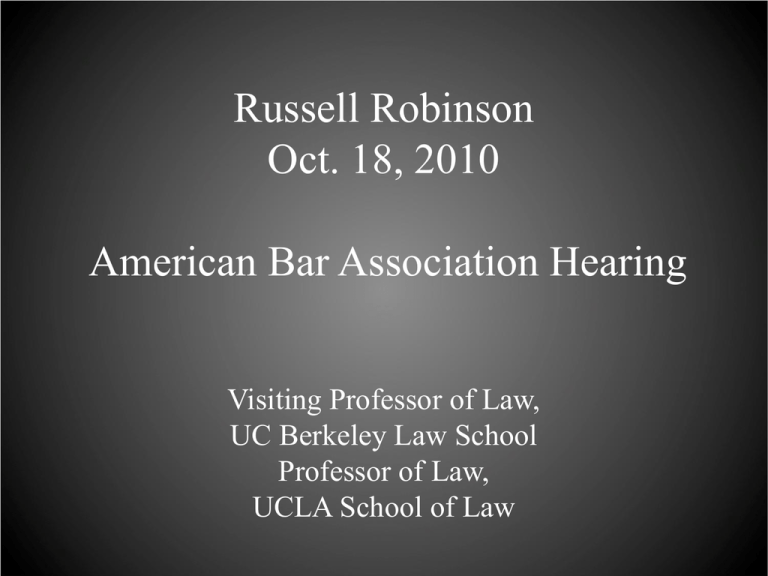Russell Robinson Oct. 18, 2010 American Bar Association Hearing Visiting Professor of Law,
advertisement

Russell Robinson Oct. 18, 2010 American Bar Association Hearing Visiting Professor of Law, UC Berkeley Law School Professor of Law, UCLA School of Law Domestic Incidence Visiting Professor of Law, UC Berkeley Law School Acting Professor of Law, UCLA School of Law Disproportionate Risks of HIV Infection Visiting Professor of Law, UC Berkeley Law School Acting Professor of Law, UCLA School of Law Overview of impact of HIV transmission laws 1. A key study found a mere 316 prosecutions over 15 years 2. Roughly 21 prosecutions a year 3. By contrast, there are 50,000 new infections each year (750,000 instances during 15-yr time period) 4. 25% of states had no prosecutions 5. Prosecutions typically aimed at people who had broken additional laws, at least 70% Sweeping Scope of HIV Transmission Laws Require disclosure of HIV status before engaging in many low or no-risk activities, including mutual masturbation or penetration with a sex toy. They apply to oral sex, which most public health experts consider to be low risk. They do not inquire into the HIV- status of the victim. They do not require that the victim be actually infected through the exposure. Most states do not consider whether the non-discloser used a condom. They generally do not distinguish between high risk and low-risk sexual activities. HIV Risk Levels Probability of HIV transmission for HIV-negative persons engaging in sex acts with HIV-positive partners Unprotected anal sex: Insertive Unprotected anal sex: Receptive 1 in 2,000 1 in 50 Protected anal sex: Insertive Protected anal sex: Receptive 1 in 20,000 1 in 500 Unprotected vaginal sex: Male Unprotected vaginal sex: Female 1 in 2,000 1 in 1,000 Unprotected oral sex: Insertive Unprotected oral sex: Receptive negligible 1 in 2,500 Cunnilingus, Analingus negligible Source: Galletly and Pinkerton, 2004 Sexual Orientation Identities 90.2% 90.3% Male Female 2.3% 1.3% Heterosexual Source: Mosher Homosexual 1.8% 2.8% Bisexual 3.9% 3.8% Something Else 1.8% 1.8% Did Not Report Sexual Orientation Identities Identifying as "Something Else" 7.5% 7.3% 6.5% 6.1% 2.3% White 2.3% Latino/a Male Source: Mosher Black Female CDC study on young black men who have sex with men in 6 major cities 2002 study, which was based on data from 19941998 920 black MSM, ages 15-22 Asked if they knew their HIV status and then tested Source: CDC, 2002 16% tested positive Findings 93% of those who were positive were unaware of their infection Of those with unrecognized infection, 71% stated before testing that there was no chance, that it was very unlikely or unlikely that they were infected with HIV 36% of the sample had never been tested for HIV; most of the remainder did not test regularly Source: CDC, 2002 Those who had an unrecognized infection and had recently engaged in unprotected anal sex gave the following reasons for not using condoms: They “knew” they were HIV-negative (24%) They “knew” their partners were HIV-negative (20%) They thought their partners were at low risk of infection (35%) Source: CDC, 2002 Condoms were not available (43%)

